*NURSING > QUESTIONS & ANSWERS > NUR2513 Section ONPC1A0M Maternal-Child Nursing (11 Weeks) - Fully on Campus - 2024 Winter Quarter M (All)
NUR2513 Section ONPC1A0M Maternal-Child Nursing (11 Weeks) - Fully on Campus - 2024 Winter Quarter Module 06 Assignment: Child Development Activity
Document Content and Description Below
NUR2513 Section ONPC1A0M Maternal-Child Nursing (11 Weeks) - Fully on Campus - 2024 Winter Quarter Module 06 Assignment: Child Development Activity Question 1 Discipline is a method of setting boun... daries to allow a child to be aware of expectations. Which of the following are methods of discipline supported by the American Academy of Pediatrics? SELECT ALL THAT APPLY • Positive reinforcement of appropriate behaviors • Spanking with hand instead of a paddle or belt • Setting age-appropriate limits and expectations for behaviors • Time outs Question 2 Which of the following correctly represents the progression of fine motor development for an infant? 1. 1mo- head lag 2. 4mos- rolls back to side 3. 6-7mos- bears full weight on feet 4. 10mos- changes from prone to sitting position 5. 12mos- walks with one hand held 1. 1mo- grasps 2. 4mos- rolls back to side 3. 6-7mos- passes object from hand to hand 4. 10mos-changes from prone to sitting position 5. 12mos- builds a tower of 2 blocks 1. 1mo- grasps 2. 4mos- brings hands together and grasps object with 2 hands 3. 6-7mos- passes object from hand to hand 4. 10mos-pincer grasp 5. 12mos- builds a tower of 2 blocks Question 3 A nurse is completing a pain assessment on an infant. Which of the following pain scales should the nurse use? • FACES • Non-communicating children’s pain checklist • FLACC • Oucher Question 4 Match the age with the gross motor developmental milestone that is expected: PROMPTS 15 months 18 months 24 months 30 months 3 years GROSS MOTOR DEVELOPMENTAL o Jumps off of a chair. o walks upstairs alone, both feet on the same step. o creeps up stairs. o runs and jumps in place. o alternates feet on stairs. o can draw a six-part figure. o Skips. o opens doors by turning knobs. o scribes voluntarily. ANS: REMEMBER: There is a difference between GORSS MOTOR and FINE MOTOR! • TEXTBOOK: Pages 825, 843 • ATI Care of Children Manual: CHAPTER 4 HEALTH PROMOTION OF TODDLERS (1 TO 3 YEARS) p21 Question 5 Match the Pain Assessment Tool with its description: Prompts FACES Numeric (visual analog) scale FLACC OUCHER Description • consists of six photographs of children’s faces representing “no hurt” to “biggest hurt you could ever have.” • consists of six cartoon-like faces ranging from smiling to tearful. • child colors in the figure drawing at the point where pain is felt and rates the present pain from “no pain” to “worst possible pain.” • uses four red poker chips placed in a horizontal line in front of the child. • incorporates five types of behaviors that can be used to rate pain: facial expression, leg movement, activity, cry, and consolability. • uses a line with end points marked “0 = no pain” on the left and “10 = worst pain” on the right. • Textbook- Chapter 39: Pain Management • RN NURSING CARE OF CHILDREN CHAPTER 9 PAIN MANAGEMENT Question 6 Match the child with the expected social characteristics of play: Prompts: 3 months old male 2 year old male 4 year old female 8 year old male Social Characters of Play: • plays frequently with imaginary friends. • Plays with an organized structure or compete for desired goal or outcome. • plays independently but among other children, not interactively. • watches particular play intently, although not actively engaged in it. RN NURSING CARE OF CHILDREN CHAPTER 10 HOSPITALIZATION, ILLNESS, AND PLAY p51 Textbook page 854, 1014 Question 7 2.5 Points Select the answer choice below that shows the correct expected order of events in pubertal development for males. 1-Breast development 2-Pubic hair growth 3-Axillary hair growth 4-Menstruation 1-Testicular enlargement 2-Pubic hair growth 3-Penile enlargement 4-Growth of axillary hair 5-Facial hair growth 6-Vocal changes 1-Pubic hair growth 2-Growth of axillary hair 3-Testicular enlargement 4-Penile enlargement 5-Facial hair growth 6-Vocal changes 1-Vocal changes 2-Pubic hair growth 3-Penile enlargement 4-Growth of axillary hair 5-Facial hair growth 6-Testicular enlargement Question 8 Many changes occur for females during pubertal development. Select the answer choice below that shows the correct expected order of events in pubertal development for females. 1- Breast development 2- Axillary hair growth 3- Menstruation 1- Menstruation 2- Breast development 3- Axillary hair growth 1- Axillary hair growth 2- Menstruation 3- Breast development Question 9 Sleep is an essential facilitator of growth, and therefore more sleep will be required during periods of rapid growth. Which age groups require the greatest amount of sleep to facilitate the most rapid periods of growth? SELECT ALL THAT APPLY • Infants • Toddlers • Preschoolers • Adolescents Question 10 Which of the following children should have dental visits every 6 months? SELECT ALL THAT APPLY • 6-month-old infant with eruption of the lower central incisors • 18-month-old male • 5-year-old female • 11-year-old male with orthodontic braces • 16-year-old male Question 11 Parents do not need to schedule a dental visit for their children until they are at least 5 years of age. • True • False Question 12 For children under 6 months of age, oral fluoride supplementation is recommended • True • False Question 13 Language development occurs rapidly throughout the infant and toddler stages. Match the child listed below with the expected language capabilities for their age. Prompts 3 month old male 5 months old female 2 month old male 12 month old male 2yo female 9 month old female 4yo female Expected Language Capabilities o Says simple words like "da da" or " ba ba" o Combines 2-3 words in a sentence. o Laughs and squeals o Vocalizes with cooing noises o Vocabulary of about 1500 words. Asks questions constantly. o Says 3-5 words o Able to write and recite poetry. o Makes single vowel sounds Textbook page 799, 826, and 843 ATI Care of Children Manual- Chapters 3, 4, and 5 Question 14 Match the child with the expected Level/Stage of moral development according to Kohlberg: Prompts 30 month old female 5yo male 8yo female 11yo male 18yo female Level/Stage of moral development Postconventional Stage 5 Postconventional Stage 1 Preconventional Stage 2 Preconventional Stage 3 Preconventional Stage 1 Conventional Stage 3 Conventional Stage 4 Question 15 It is important to consider the level of development when forming expectations for a child's behavior. Kohlberg's Theory of Moral Development categorizes children at different ages according to their moral reasoning capabilities. Match each stage of moral development below with the description of the individuals’ abilities during that stage: Prompts Preconventional- stage 1 Conventional- stage 3 Postconventional- stage 5 Preconventional- stage 2 Conventional- stage 4 Postconventional- stage 6 Description Of The Individuals’ Abilities Child does right because a parent tells them to and to avoid punishment. Carries out actions to satisfy own needs rather than society’s. Follows internalized standards of conduct. Follows standards of society for the good of all people. Child follows rules because of a need to be a good person in own eyes and eyes of others. Follows rules of authority figures as well as parents in an effort to keep the system working. Question 16 Match the child with the desired developmental outcome according to Jean Piaget. Prompts 9 month old female 2 year old male 4 year old female 9 year old male 16 year old female Desired Developmental Outcome o Begins to understand the time sequence of daily events. o Learns that an object still exists when it is out of view. o Able to understand how the actions of an individual influence others o Symbolizes objects and people to imitate previously seen activities. o Develops a sense of trust. o Able to see the perspective of others o Establishes a sense of autonomy. Question 17 Match the age group with the goal according to Erikson. Prompts Infants Toddlers Preschoolers School age Adolescents Goal o Develops a cohesive, positive sense of self that allows them to contribute to society. o Learns to believe in their ability to successfully pursue goals via initiating tasks. o Begins to view others as worthy of trust via having their needs consistently met. o Begins to develop self-reliance and self-confidence if allowed to develop at their own pace via exploration of attempting to complete tasks independently. o Learns to be productive and accept evaluation of their efforts. o Develop the ability to be less egocentric and to think logically. o Develops the ability to think abstractly. [Show More]
Last updated: 3 months ago
Preview 1 out of 7 pages
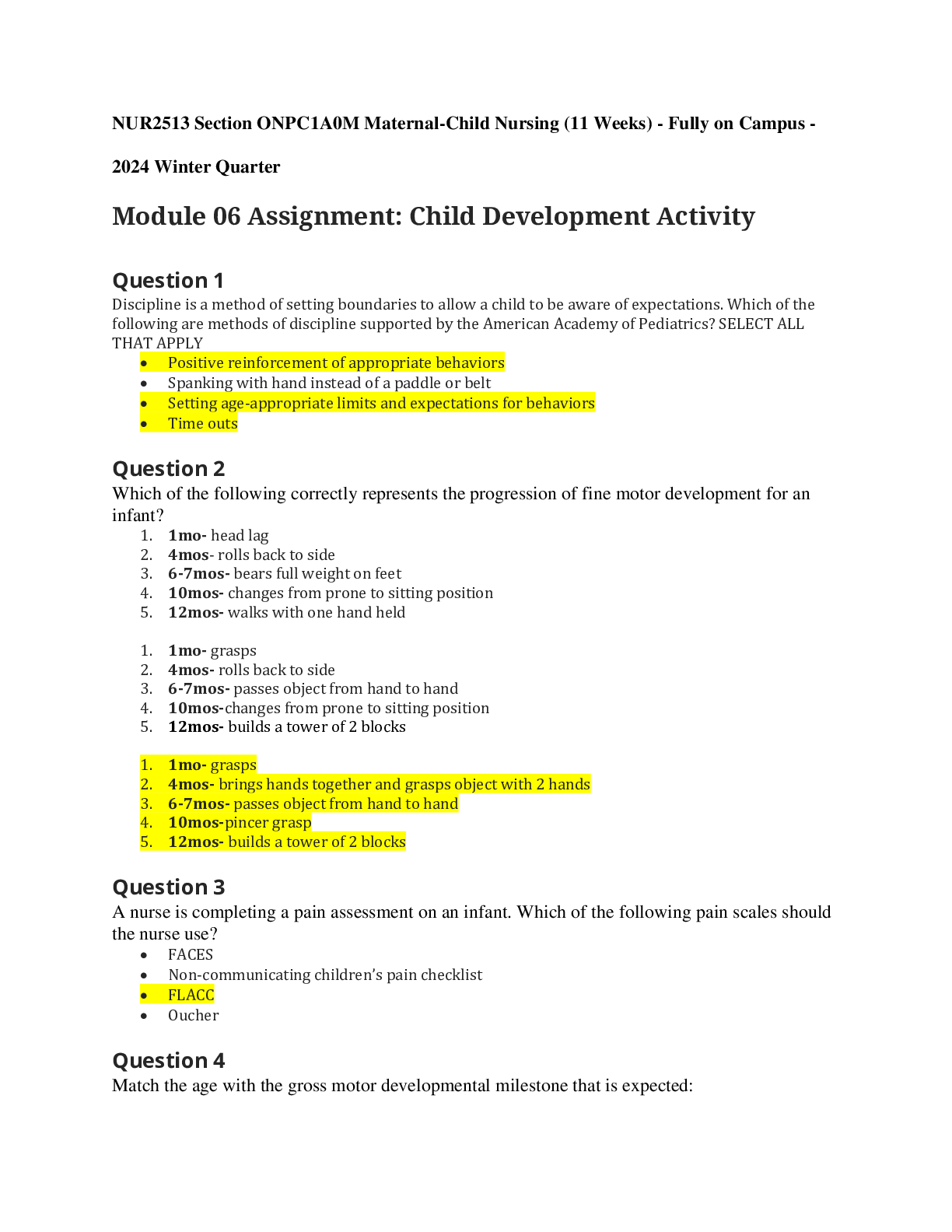
Reviews( 0 )
Document information
Connected school, study & course
About the document
Uploaded On
Feb 04, 2024
Number of pages
7
Written in
Additional information
This document has been written for:
Uploaded
Feb 04, 2024
Downloads
0
Views
37

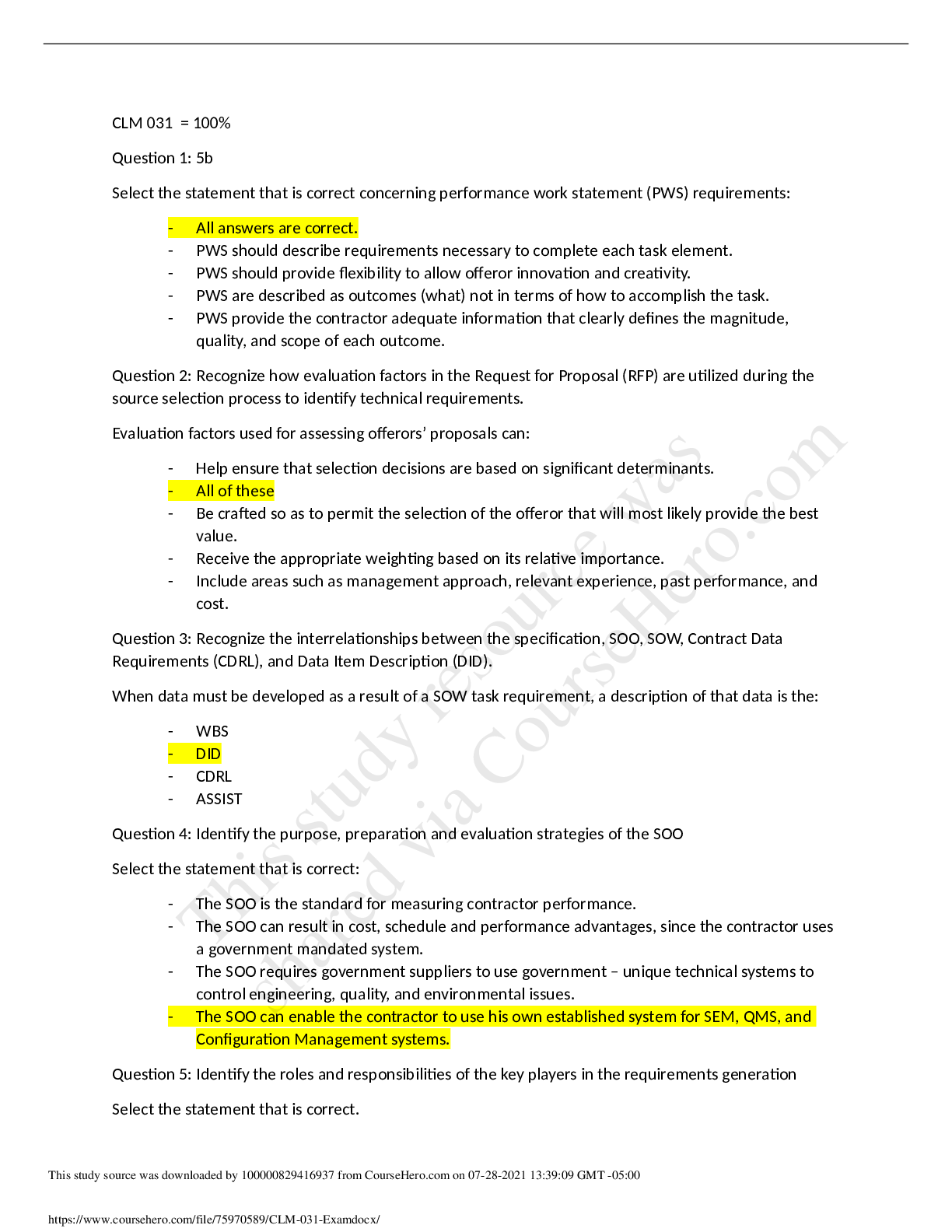



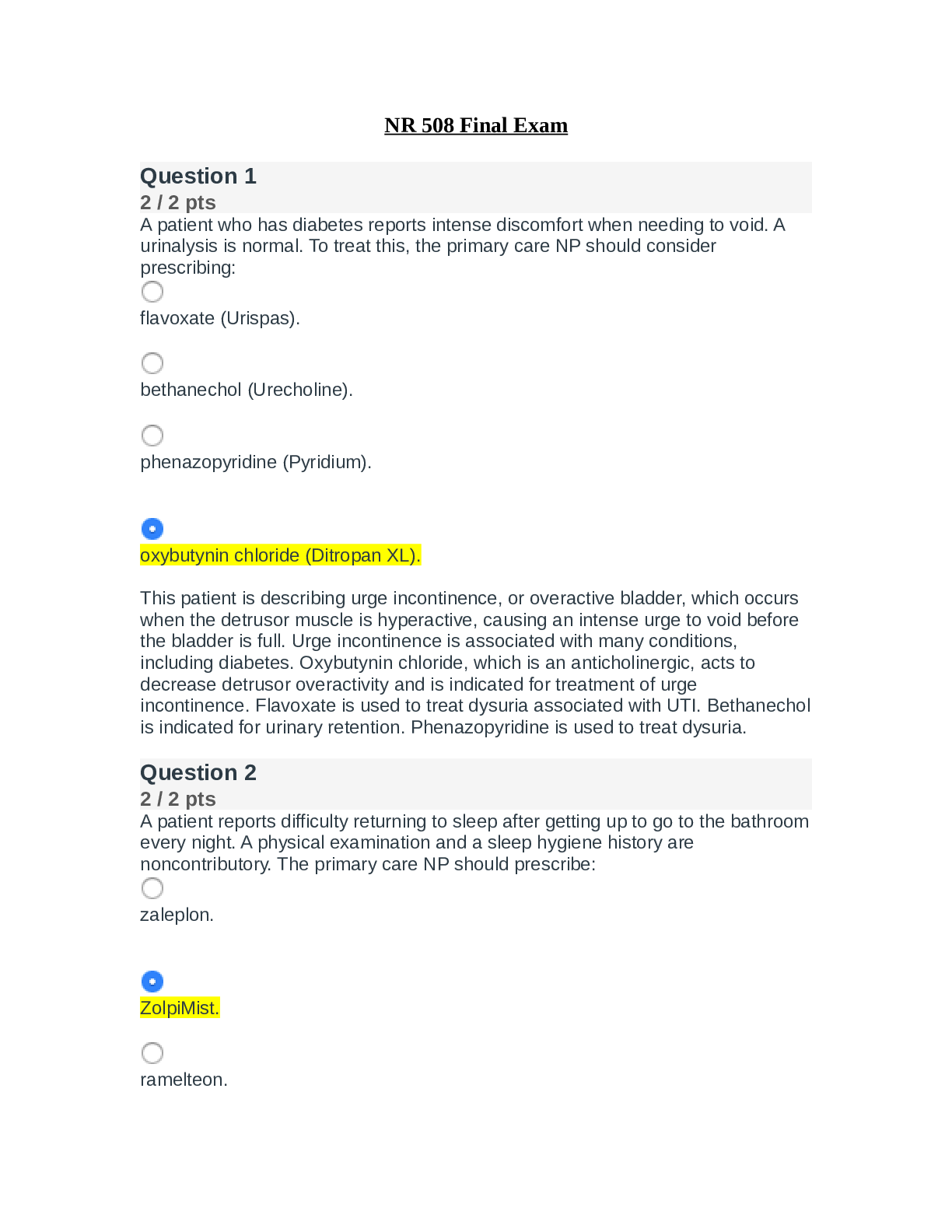
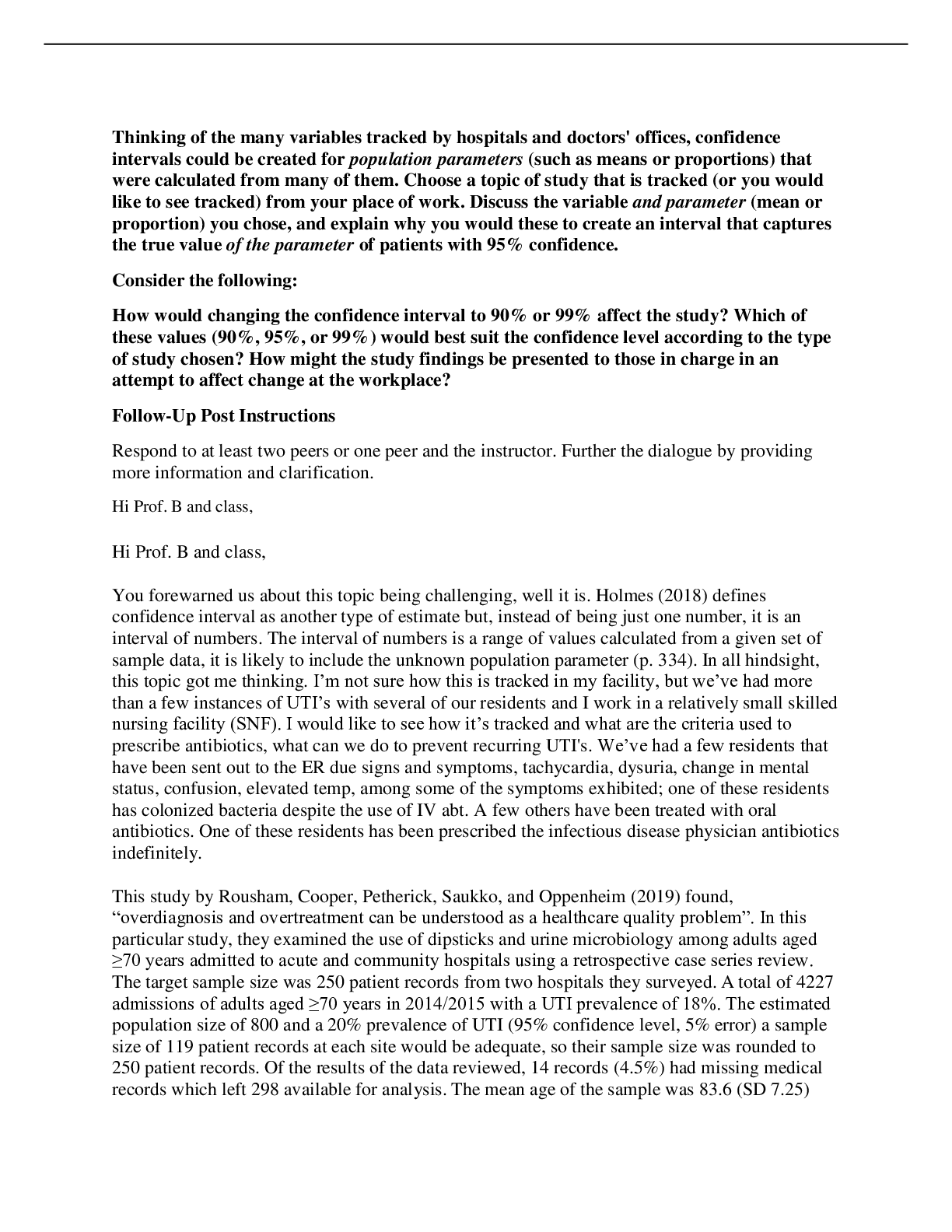

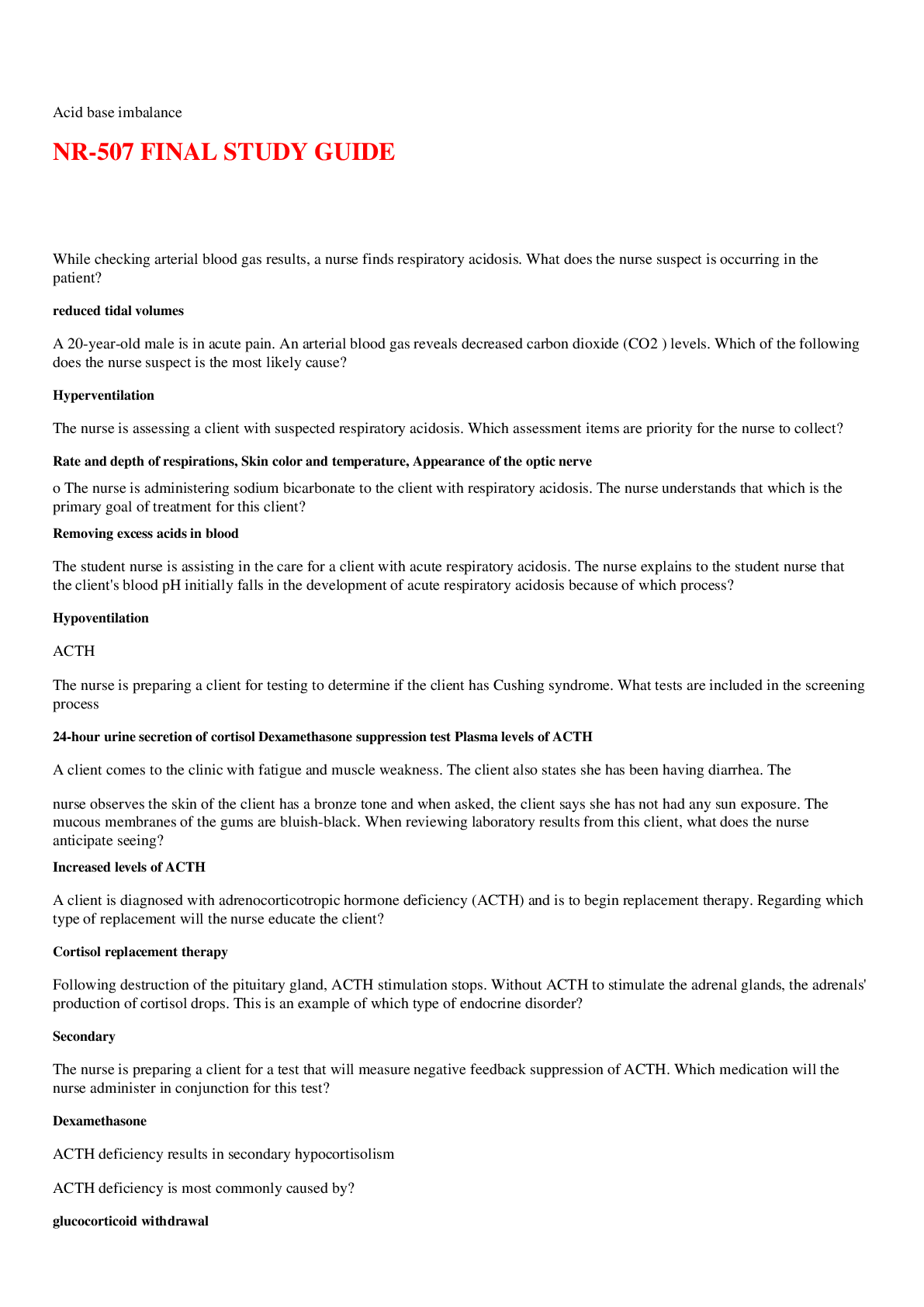



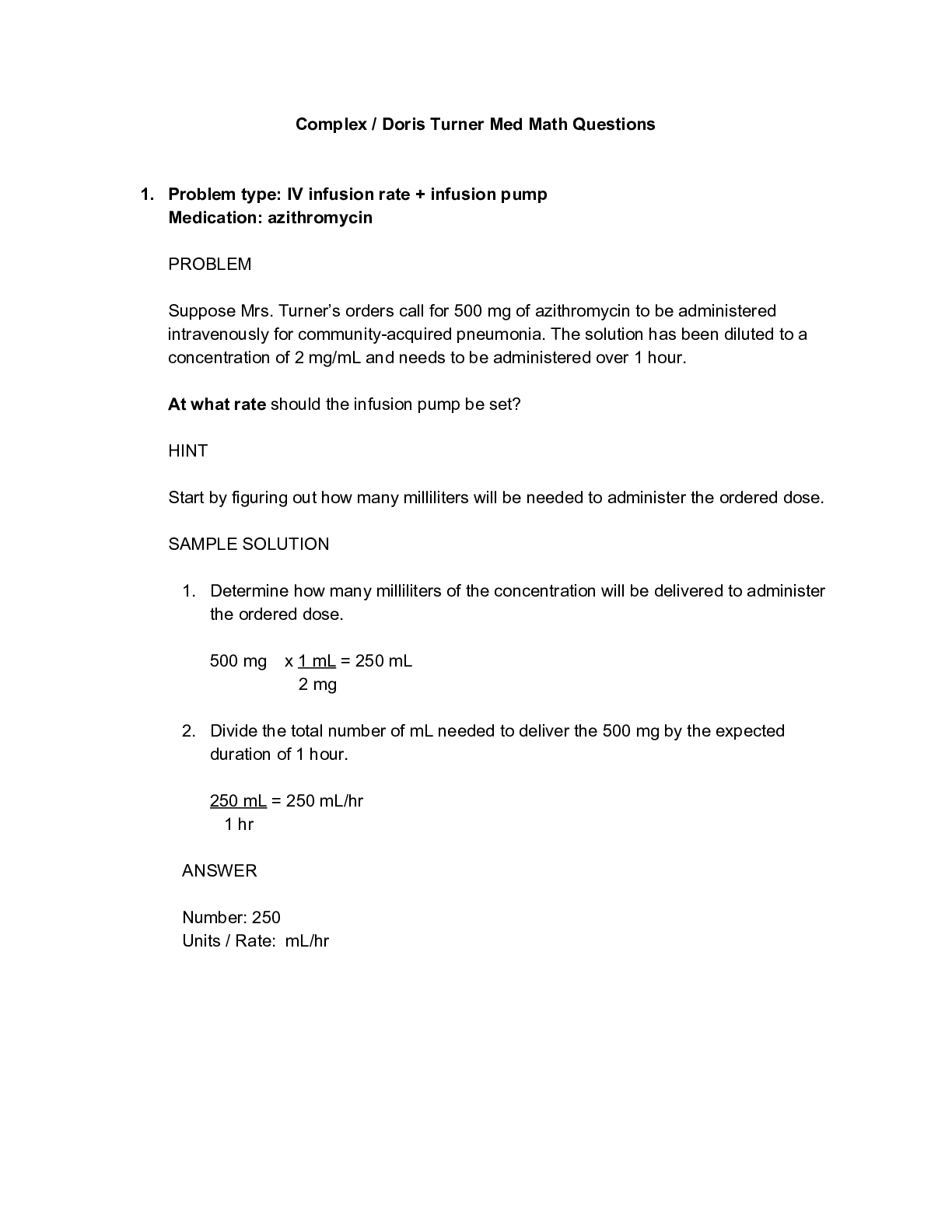
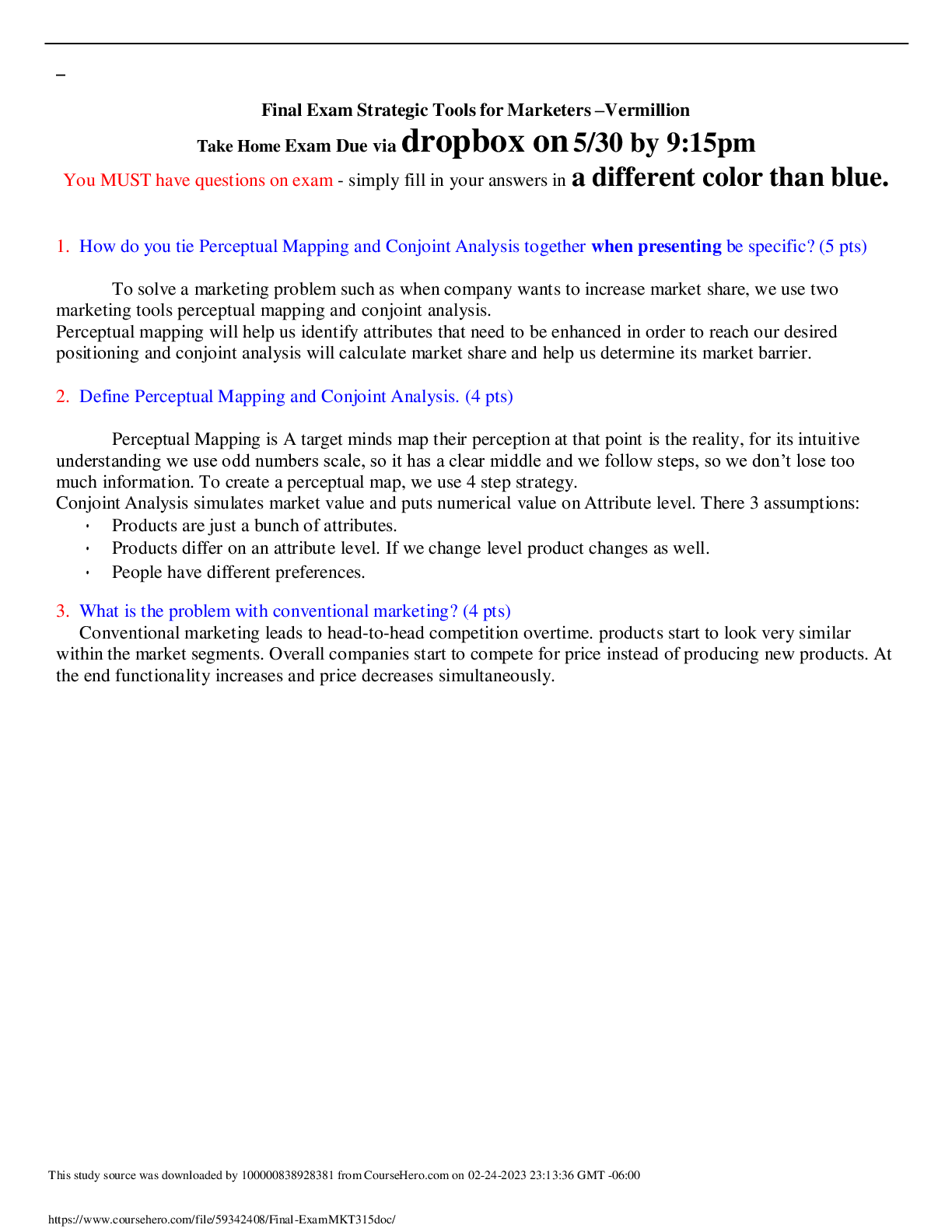
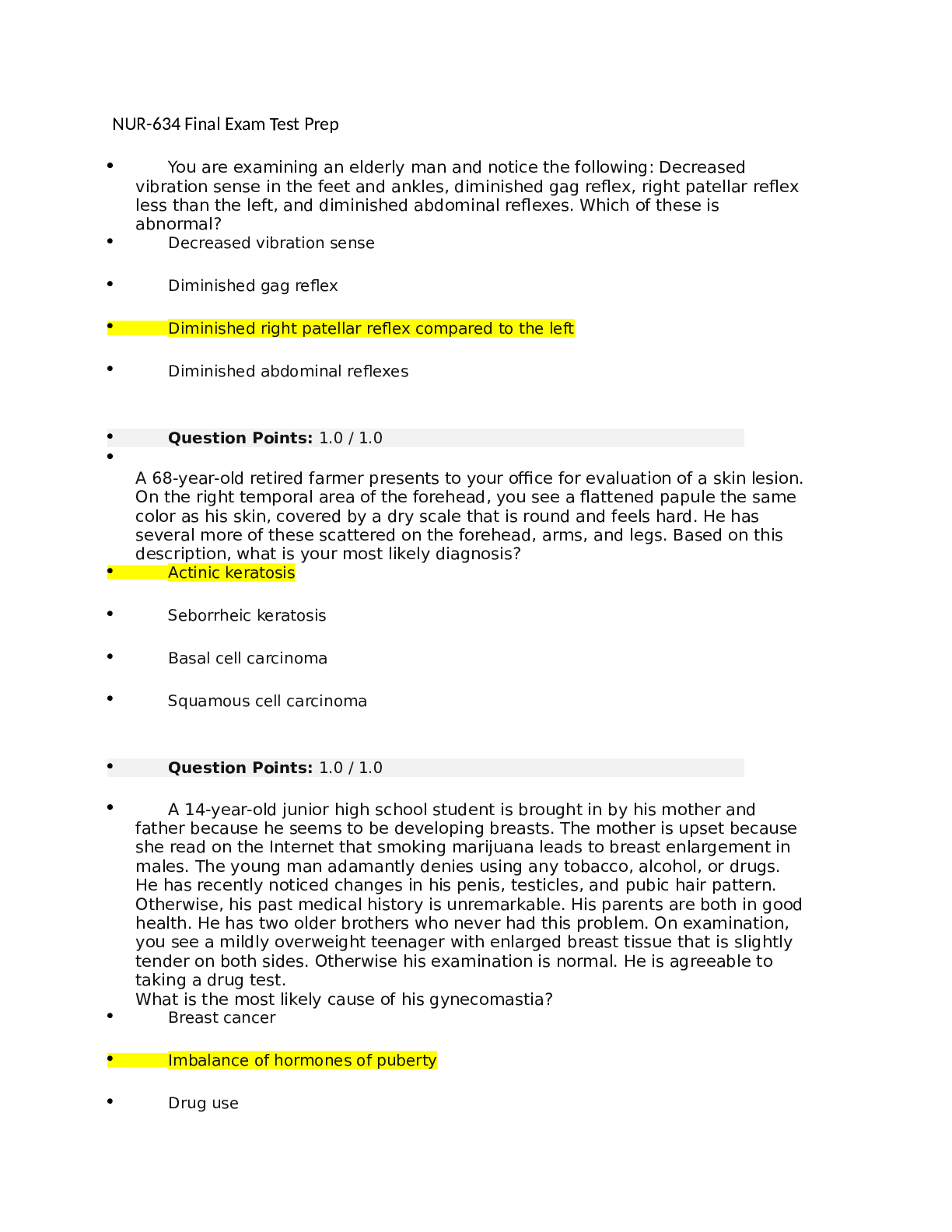
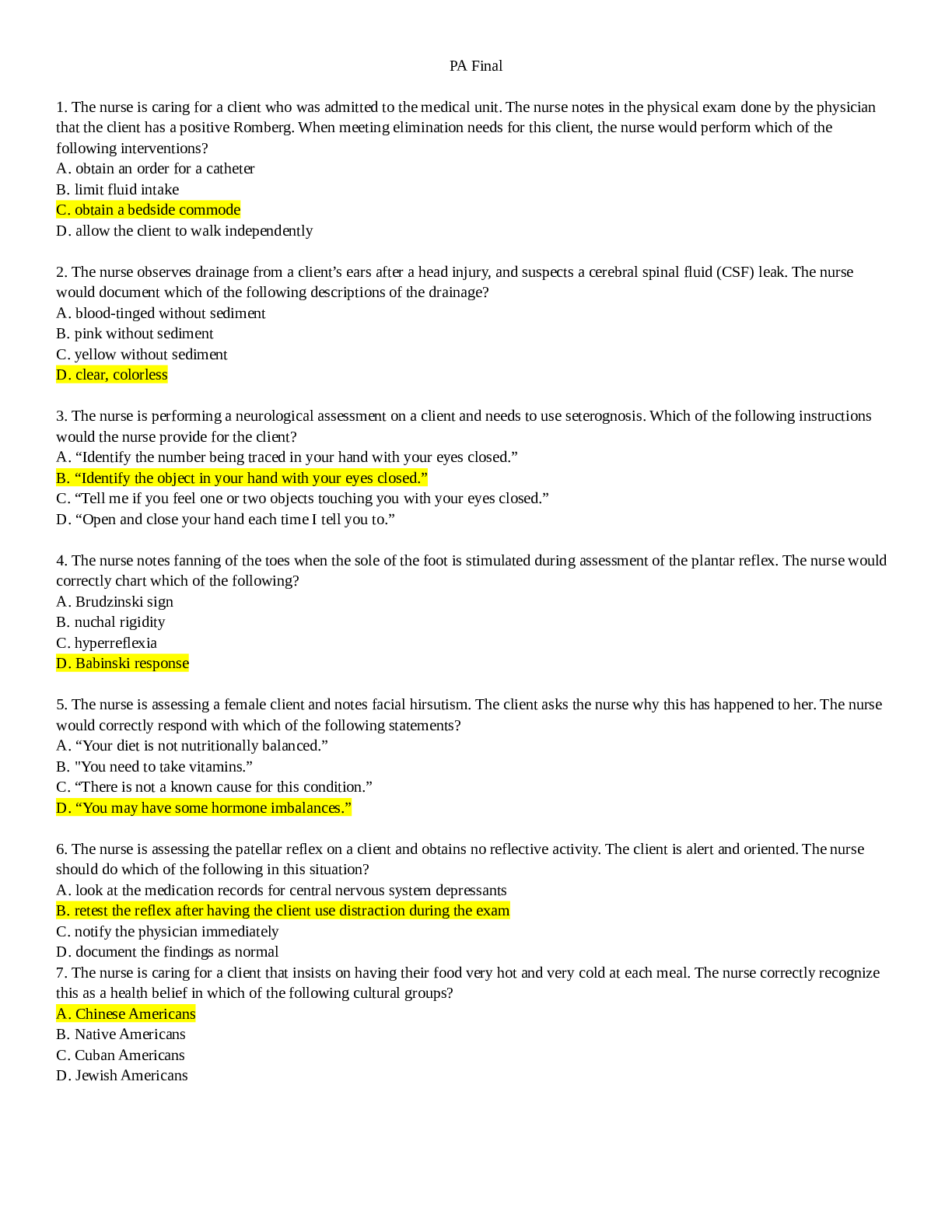

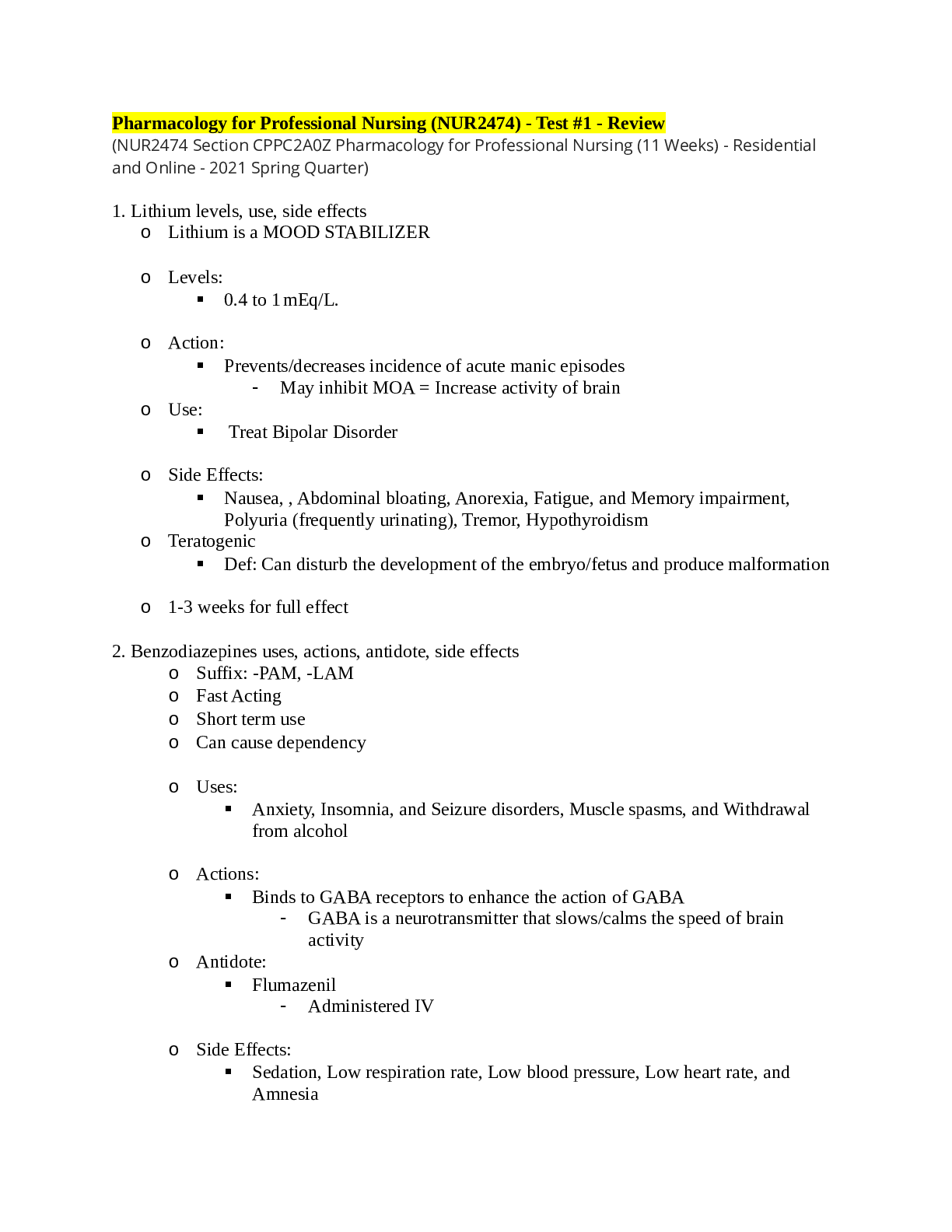
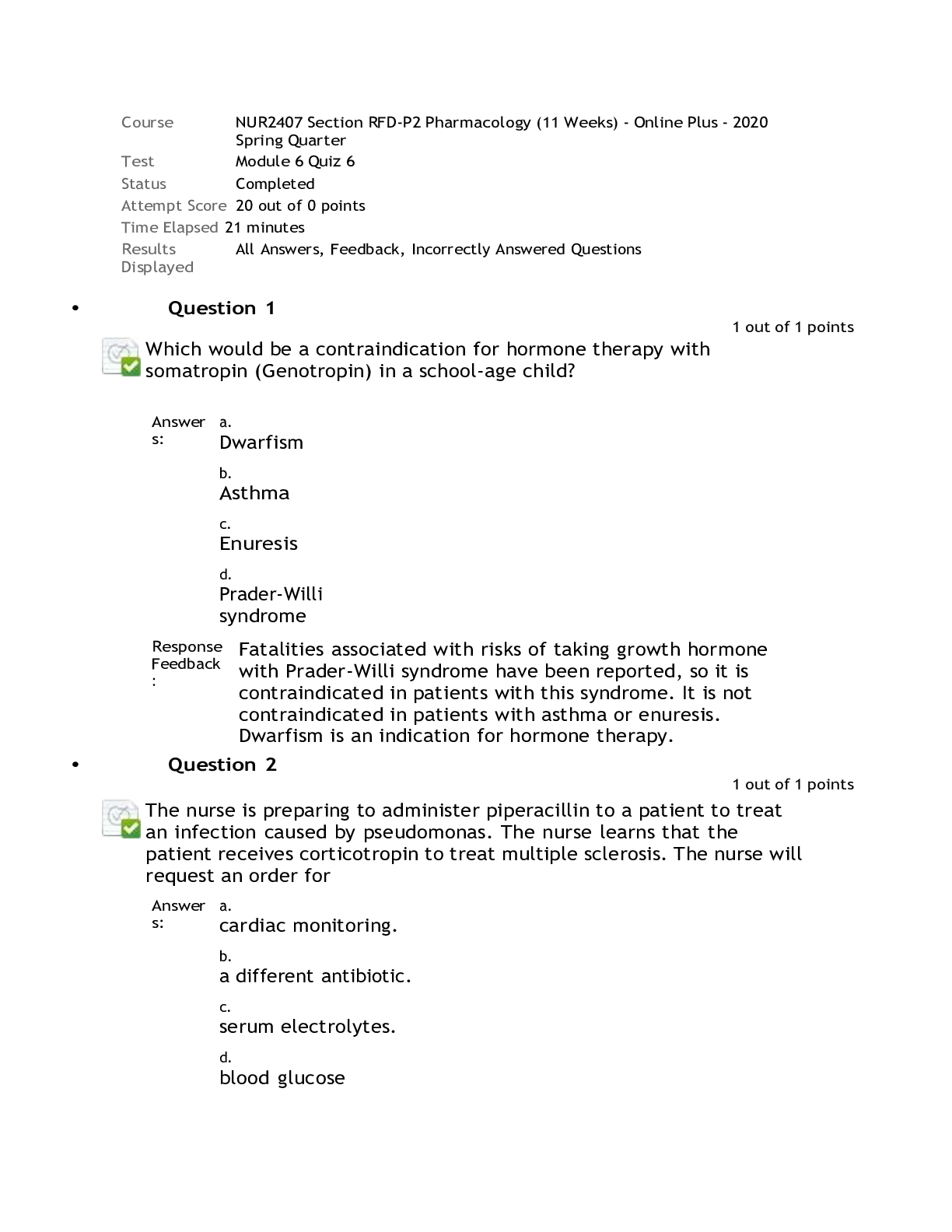



.png)

.png)




.png)
.png)

.png)




